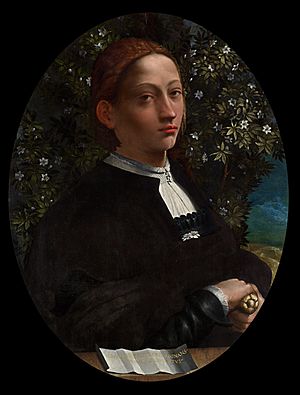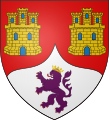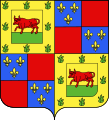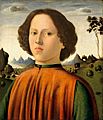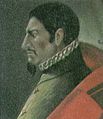House of Borgia facts for kids
Quick facts for kids BorgiaBorja
|
|
|---|---|
| Papaline noble family | |
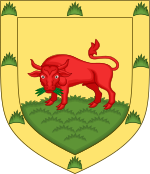
Arms of Borgia family
(Or a bull gules upon a terrace vert in a bordure Or charged with eight flames vert.)
|
|
| Country |
|
| Etymology | From the Spanish town of Borja |
| Founded | 1455 |
| Founder | Pope Callixtus III (de facto) |
| Current head | R.N. Borja; took over 2020; direct line extinct |
| Final ruler | María Ana, 12th Duchess of Gandía |
| Titles |
|
| Members | |
| Distinctions |
|
| Traditions | Roman Catholicism |
| Dissolution | 1748 |
The House of Borgia (also known as the Borja family) was a powerful and important noble family from Spain. They became very famous during the Italian Renaissance in the 15th and 16th centuries. Their family name comes from the town of Borja in Spain.
The Borgias became very important in the Church and in politics. Two members of their family became popes: Alfons de Borja (who was Pope from 1455 to 1458) and Rodrigo Lanzol Borgia (who was Pope from 1492 to 1503).
During the time of Pope Alexander VI, the family was known for their strong desire for power. This led them to make enemies with other powerful families like the Medici and the Sforza. However, the Borgias were also great supporters of the arts, helping to develop Renaissance art. While they are often seen as a family involved in many controversies, some historians believe that this view might be unfair.
Contents
The Rise of the Borgia Family
Early Beginnings
The Borja family was a noble house that started in the town of Borja in Spain. They were a respected family in the Crown of Aragon. Over time, they moved to Italy and became known as the Borgias.
Alfons de Borja: Pope Callixtus III
Alfons de Borja (1378–1458) was born in Valencia, Spain. He was a law professor and a diplomat for the Kings of Aragon before he became a cardinal. In 1455, when he was older, he was chosen to be Pope Callixtus III. He was Pope for only three years until he passed away in 1458.
Rodrigo Borgia: Pope Alexander VI
Rodrigo Borgia (1431–1503) was born in Xàtiva, Spain. He studied law and was made a cardinal by his uncle, Pope Callixtus III. In 1492, he was elected Pope and took the name Alexander VI. While he was a cardinal, he had children, including Giovanni, Cesare, Lucrezia, and Gioffre.
As Pope Alexander VI, Rodrigo was known as a very skilled politician and diplomat. He worked to increase his own power and the wealth of the Church. He often gave important positions and riches to his family members. For example, he made his son Giovanni the leader of the papal army. He also made another son, Cesare, a cardinal.
Pope Alexander VI used the marriages of his children to form alliances with other powerful families in Italy and Spain. He arranged for Lucrezia to marry Giovanni Sforza to connect with the powerful Sforza family. He also married his youngest son, Gioffre, to Sancha of Aragon from the Spanish royal family. These marriages helped him build strong connections and influence.
Pope Alexander VI passed away in Rome in 1503. Later popes, like Sixtus V and Urban VIII, even called him one of the most important popes since St. Peter.
Cesare Borgia: A Powerful Leader
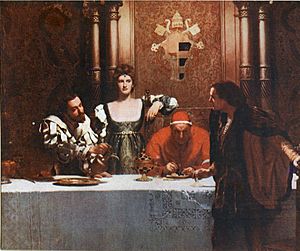
Cesare was the second son of Rodrigo Borgia (Pope Alexander VI) and Vannozza dei Cattanei. His father carefully planned his education. Cesare grew up to be a charming man who was good at war and politics. He studied law and theology at universities. After graduating, his father made him a cardinal.
Cesare later left his Church position to become a military leader, a role his brother Giovanni had held. He married the French princess Charlotte d'Albret.
After his father, Pope Alexander VI, died in 1503, Cesare tried to influence who would become the next Pope. He wanted someone who would support his plans to create his own territory in Italy. His chosen candidate, Pius III, became Pope but died very soon after. Cesare then had to support Giuliano della Rovere, who promised Cesare he could keep his titles. However, della Rovere later became Cesare's strong enemy.
Cesare died in 1507 during a battle at Viana Castle in Spain. He was trying to capture the castle but was killed during the fight.
Lucrezia Borgia: A Life of Alliances
Lucrezia was born in Italy to Cardinal Rodrigo Borgia and Vannozza dei Catanei. When she was young, she was engaged to two Spanish princes. After her father became Pope, she married Giovanni Sforza in 1493 when she was 13. This marriage was a political move to help her father gain power. However, when the alliance was no longer needed, the marriage was ended in 1497.
Lucrezia's second marriage was to the wealthy young Prince Alfonso of Aragon. This marriage helped the Borgias form another powerful alliance. But this relationship also did not last long. Cesare wanted to strengthen his ties with France and break away from the Kingdom of Naples, which was ruled by Alfonso's father. Because of this, Alfonso was in great danger and was later killed.
Lucrezia's third and final husband was Alfonso I d'Este, Duke of Ferrara. After her father died in 1503, she lived a more independent life in Ferrara with her husband and children. She faced difficulties with her pregnancies and lost several babies. She passed away in 1519, shortly after the birth and death of her last child.
Lucrezia was sometimes rumored to be involved in political plots. However, some modern historians see her as a victim of her family's political strategies.
Family Tree
Other Important Borgia Family Members
- Rodrigo de Borja (born 1349), an early head of the Borja family.
- Pedro Luis de Borja (1432–1458), Duke of Spoleto.
- Giovanni Borgia, 2nd Duke of Gandia (1474 or 1476 – 1497), son of Pope Alexander VI.
- Gioffre Borgia (1482–1516), the youngest son of Pope Alexander VI. He became the Prince of Squillace.
- Francis Borgia, 4th Duke of Gandía (1510–1572), a great-grandson of Pope Alexander VI. He became a very important leader in the Society of Jesus and was later made a saint.
- Juan de Borja y Castro (1533–1606).
- Gaspar de Borja y Velasco (1580–1645), a cardinal and important Church leader in Spain.
- Francisco de Borja y Aragón (1581–1658), Prince of Squillace and Viceroy of Peru.
- Rodrigo Borja Cevallos (1935), a former President of Ecuador.
Images for kids
-
Coat of arms of the dukes of Gandía.
-
Alfons de Borja
Pope Callixtus III. -
Rodrigo Borja
Pope Alexander VI, father of Cesare, Giovanni, Lucrezia and Gioffre. -
Portrait of a Gentleman, Cesare Borgia
Duke of Valentinois. -
Gioffre Borgia
Prince of Squillace. -
Francisco Borgia
Saint Francis Borgia, S.J., 4th Duke of Gandia. -
Juan Buenaventura de Borja, President of the Real Audiencia de Santa Fe de Bogotá.
-
Gaspar de Borja y Velasco
Cardinal, Primate of Spain, Archbishop of Seville, and Archbishop and Viceroy of Naples. -
Francisco de Borja y Aragón
Prince of Squillace and Viceroy of Peru.
See also
 In Spanish: Casa de Borja para niños
In Spanish: Casa de Borja para niños
- Grandee of Spain
- List of popes from the Borgia family
- Borgia castles
- Route of the Borgias
- Borgia Apartments
- Monastery of Sant Jeroni de Cotalba
- Ducal Palace of Gandia
- Oratory of the Borgias
- Tower and walls of the Borgias
- Palace of the Borgias
- Birthplace of Pope Alexander VI


